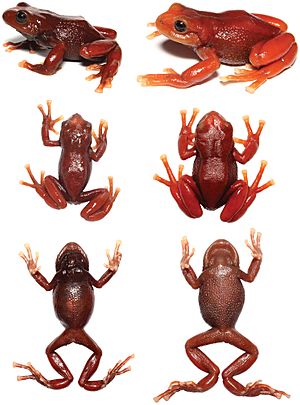Pristimantis erythros facts for kids
Quick facts for kids Pristimantis erythros |
|
|---|---|
 |
|
| Lateral, dorsal and ventral views of a male (left) and a female (right). | |
| Scientific classification | |
| <mapframe latitude="-2.6825" longitude="-79.03305556" zoom="13" text="Place where the holotype was found in Ecuador" width="250" height="250" align="center" /> |
The Pristimantis erythros is a special kind of amphibian, like a frog or toad. It belongs to the family Craugastoridae. You can find this unique frog only in Cajas National Park in the Chiquintad parish of Ecuador.
What makes this frog stand out is its bright scarlet red color. This color helps tell it apart from all other frogs in its group, called Pristimantis. It also has special glands, called parotid glands, on its shoulders.
Female Pristimantis erythros frogs are usually about 38 to 42 millimeters long. Males are a bit smaller, around 37 millimeters. Unlike many frogs, this species does not have a tadpole stage that lives in water. Instead, its eggs develop directly into tiny frogs.
Scientists officially described this frog on April 20, 2018. They published their findings in a science journal called ZooKeys. The name erythros comes from the Greek word for "red," which perfectly describes its color. This frog is considered critically endangered because it is losing its home and lives in a very small area.
Contents
Discovering the Red Rain Frog
Scientists officially described the Pristimantis erythros on April 20, 2018. A team of six researchers, including Juan C. Sánchez-Nivicela and Diego F. Cisneros-Heredia, wrote about it in the scientific journal ZooKeys.
They found that this frog belongs to the Pristimantis group. Its closest relative seems to be another frog called P. orcesi. The Pristimantis erythros is special because of its bright red color and unique glands on its shoulders.
The first adult female frog, known as the holotype, was found in October 2014. It was discovered in the Chiquintad parish, in Azuay province, Ecuador. This spot is very high up, at about 3,449 meters (over 11,300 feet) above sea level. Other frogs, called paratypes, including males, females, and young frogs, were found in the same area in late 2014.
The second part of its scientific name, erythros, comes from the Greek word for "red." This name was chosen because of the frog's striking red skin, which helps people easily tell it apart from other species.
Where the Red Rain Frog Lives
The only place where scientists have seen the Pristimantis erythros is in Cajas National Park. Specifically, it lives in the parish of Chiquintad, Ecuador. This area is a type of grassland called páramo, which has many grasses and shrubs.
All the frogs found so far have been living in special plants called terrestrial bromeliads (like Puya hamata) and tall grasses (like Neurolepis villosa). They are usually found close to small streams.
Protecting the Red Rain Frog
The park where this frog lives is generally well-protected. However, people living nearby are causing problems for the frog's home. Things like changing the plants in the area and how people use the land are making the frog's habitat shrink.
Because of these issues, the Pristimantis erythros is losing its home. Its living area is now smaller than one square kilometer. This is why the scientists who discovered it believe it is a critically endangered species. This means it is at a very high risk of disappearing forever. The International Union for Conservation of Nature (IUCN) has not yet officially listed its conservation status, but researchers are very concerned.
What the Red Rain Frog Looks Like and Does
Female Pristimantis erythros frogs are usually between 38.8 and 42.6 millimeters long. Males are a bit smaller, measuring about 36.7 to 37 millimeters. The frog's head is about as wide as its body.
Its snout (nose area) is short and rounded. It has special glands on its shoulders, called parotid glands, which cover a large part of its upper back muscles. The frog's eardrum can be seen and is about half the size of its eye.
The back and belly of the Pristimantis erythros are a dark red color. Its legs and feet are a lighter shade of red, and its toes are a rosy color. The frog's eyes have a dark brown center with shiny golden spots.
Red Rain Frog Life Cycle and Habits
Like all frogs in its group, the Pristimantis erythros has a special way of growing up. It has what is called "direct development." This means that the eggs are laid on the forest floor, and instead of hatching into tadpoles that live in water, they hatch directly into tiny froglets. This allows them to live without needing ponds or streams for their young.
These frogs are quite vocal! They make calls twice a day. You can hear them in the morning, from 8 to 11 am, and again in the evening, from 5 to 7 pm. They are most active between dusk (when the sun sets) and 9 pm. After that, they tend to quiet down and become less active.
See also
 In Spanish: Pristimantis erythros para niños
In Spanish: Pristimantis erythros para niños

